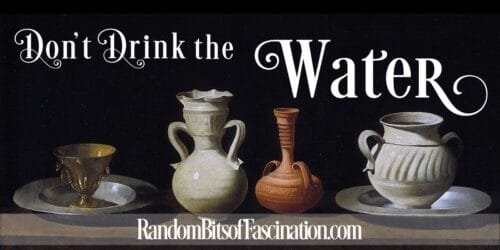Don’t Drink the Water: Coffee in Austen’s Day

It is rather impertinent to suggest any household care to a housekeeper, but I just venture to say that the coffee-mill will be wanted every day while Edward is at Steventon, as he always drinks coffee for breakfast.
Jane Austen to Cassandra
June 11, 1799

Although we are most likely to associate tea with Jane Austen’s day, chocolate and coffee were common enjoyed as well. (Find more on TEA HERE and CHOCOLATE HERE.) Coffee was commonly drunk in the home with elaborate tea sets including specialized cups for tea, coffee and drinking chocolate. In Pride and Prejudice, when the gentlemen returned to the drawing room from their after dinner port, they enjoyed coffee with the ladies. During one of these interludes Elizabeth is stationed at the coffee pot to serve the beverage to guests.
Not only was coffee enjoyed in the home, coffee houses sprang up all over Europe during the 1600’s, attaining high levels of popularity, especially among male clientele.
The Rise of the Coffee-House
In 1650, Oxford became the home of the first English coffee house, known as Angel. (Another Oxford coffee house, The Queen’s Lane Coffee House, founded in 1654, still exists today.) Oxford coffeehouses became centers for social intercourse gossip and scholarly conversation.
In 1652. London’s first coffee house opened and became part of the popular culture, much as Starbucks has become ubiquitous today. These influential establishments were used as gathering places by artists, intellectuals, merchants, bankers and as a forum for political activities and developments. Some called coffee houses ‘penny universities’ because a man could pick up more useful knowledge in an evening at the coffee house than by applying himself to his books for a whole month.

Over time, coffee houses adapted to meet the unique preferences of their unique clientele; Lloyd’s Coffee House, a favored haunt of merchants and sailors, saw shipping information was shared and deals conducted. The Grecian Coffee-House in Devereux Court catered to the Whigs; the Rainbow attracted Freemasons and French refugee Huguenots. Slaughter’s on St. Martin’s Lane, boasted an artistic clientele while the British Coffee-House on Cockspur Street, popular with the Scots, was a site of Jacobite plotting. Still other coffee houses, including the Moll King’s coffee house Covent Garden, catered to lower class tastes.
By the beginning of the 1800’s, coffeehouses were disappearing from England’s social scene. Two factors contributed to their decline. Exclusive clubs flourished, encouraging the intelligentsia to segregate their special qualities away from the pollution of the common man. At the same time, the British East India Company influenced government policies to stimulate the demand for tea. Though few coffeehouses survived this period, people still enjoyed coffee in their own drawing rooms.
Brewing it up like Jane Austen
A number of period cookbooks from Austen’s era touched on the subject of coffee and its virtues.
COFFEE.
(Perkins, 1796)
Many virtues have been ascribed to this berry, which it never possessed; and much undeserved censure has been thrown upon its use. It is certainly good in weakness of the stomach, head-ache, and want of appetite; in lethargic and sleepy diseases; but it is not good for lean and bilious people, nor for women in a state of pregnancy. Its invigorating qualities are strongly experienced, by taking it when the stomach is over-loaded with food, nauseated with surfeit, or weakened by intemperance; and it certainly takes away that listlessness and languor, which nervous people so severely feel, after any deviation to excess, fatigue, or irregularity. It is said to be of use in the gravel; and a dish of strong coffee, without milk or sugar, taken frequently in the height of an asthmatic fit, contributes much to its abatement. In the wet and damp seasons, to which the climate of England is so subject, there is no doubt but great advantage must result from the use of coffee.

Eliza Rundell suggested this method to make coffee.
The isinglass chips, a gelatin-like (collagen) substance derived from fish bladders was used to clarify the coffee, since modern coffee filters would not be invented for many years yet.
Considering how bitter this brew was likely to be, it’s no wonder cream and sugar were deemed necessary to serve with it.
Boiled coffee and fish bladder collagen aside, the coffee milk sounds like what I enjoy in the evenings (decaf of course) and share liberally with my grandbabies. (It must taste good, Nana’s drinking it, right?)
To see Period Cookbook References, click here
To read more Georgian Era Recipes, click here.
To find more Beverage Recipes, click here.
To read more about Regency era Food and Drink, click here
If you enjoyed this, you might also enjoy:

Well, that recipe sounded simply disgusting. Who would have thought to do such a thing as using fish bladder collagen to filter their coffee? Oh-my-gosh, ugh… shudder. It is a wonder people lived as long as they did. Thanks for sharing this research. Once again the EIC was a powerful influence on what England put on their table or drank with their morning cup.
Pingback:10 Beverages Popular During the Regency Era – Kat Devitt